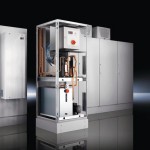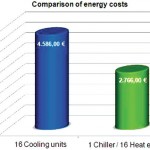Particularly in the case of larger switchgear installations, the savings potential in terms of energy costs is enormous. Both energy-efficient individual cooling units, such as those in the Cool Efficiency series, and systems with a central chilled water supply can help to realise this potential. Enclosure specialist Rittal offers a range of products with solutions for the most diverse applications.
Ralf Schneider
A typical industrial enclosure often accommodates not only the low-voltage distribution but also a variety of drive system components. Modern frequency converters, servo amplifiers and rectifiers all convert a proportion of the supplied electrical energy into heat. At high component integration levels, the power losses in a single enclo-sure can easily exceed 1 kW. Investments in energy-efficient cooling systems are necessary to be able to dissipate the heat arising from such losses.
Over the past years, Rittal has devoted increasing attention to energy-saving cooling units in its research and development activities. Special importance is attached to the optimum interaction of all components contributing to the cooling performance – first and foremost to energy and performance-optimised refrigeration compressors, which are set specifically to the desired working point for each individual application (cooling output, internal and external circuit parameters), where efficiency is at its maximum.
Even apparently insignificant details are addressed by the design engineers: The use of electronically commutated fan motors, for example, resulting in a high degree of efficiency over the whole speed range. The motors possess a dynamically balanced rotor with multi-pole magnets. The rotor position is acquired by way of Hall sensors, while precision ball bearings provide a long service life and quiet running. The geometry of the refrigeration section has also been optimised. To this end, the condenser, evaporator, cooling fins, heat exchanger surfaces, pipe bends and all other refrigeration components were subjected to a systematic analysis and modified with a view to enhanced performance. Another essential step has been to determine the ideal specifications for the refrigerant volume and the control logic: They are matched exactly to the particular application and the actual demands placed on the cooling, and thus similarly serve to raise the efficiency of the climate control system.
One outcome of this development work at Rittal has been the cooling units in the Cool Efficiency series, with cooling outputs from 500 W to 4 kW. These units, which are available in wall and roof-mounted variants, are characterised by their particularly efficient utilisation of primary electrical energy, leading to a high degree of economic efficiency. It has been calculated that the cooling units save up to 45 % compared to the primary electrical energy demand of conventional cooling units.
Chiller as an alternative
When switchgear is spread over several enclosures, as is frequently the case in industrial applications, central recooling systems are an alternative that can similarly contribute to increased efficiency. Instead of installing an individual cooling unit on each enclosure, air-water heat exchangers – such as those offered by Rittal for its TS 8 enclo-sure series – are used to transfer the unwanted heat to a cooling water circuit. If the production facility already possesses a central chilled water supply, it is possible to forego a separate refrigeration compressor. This not only reduces the investment outlay, but also translates into lower operating costs. One interesting side-effect is the option of using the thermal energy of the cooling water for heating purposes elsewhere in the facility. Where no external cooling water is available, a recooling system – for example the newly developed TopTherm Chiller – is a convenient alternative. Such systems are housed in a standard TS 8 enclosure and are available with cooling outputs from 8 kW to 40 kW. Central water chilling is in most cases significantly more efficient than the use of individual cooling units. Depending on the application at hand, the fact that it is only necessary to operate one compressor and one pump permits considerable energy savings.
The TopTherm Chiller comprises a refrigeration module, a control module and a water module to distribute the cooling water to the consumers. The modular design provides greater ease of servicing and fast delivery times, as the necessary mod-ules must only be incorporated into the enclosure to suit the specific requirements. The customer receives a complete and ready-to-connect system, and as the TopTherm Chiller is accommodated in a stand-ard enclosure, it integrates seamlessly into an existing switchgear installation. The air-water heat exchangers in the individual enclosures are then simply connected to the cooling water circuit. Corresponding flow controllers and valves ensure that each enclosure is supplied with a sufficient volume of chilled water.
Comparison with savings effect
Under no circumstances, however, should it be forgotten to compare the energy costs for the different switchgear cooling so- lutions – whether with cooling units or with air-water heat exchangers and a recooling chiller. As both the initial investment and the operating and energy costs vary from one system to another, a suitable comparison must be drawn up separately for each new application. The example of a typical switchgear installation with sixteen TS 8 enclosures, however, serves as an impressive demonstration of the savings potential. Eight of the enclosures are assumed to entail heat losses of 2300 W each, two more heat losses of 900 W each and the remaining six heat losses of 800 W each. A climate control solution based on individual TopTherm cooling units would require eight units with a rated output of 2.5 kW each and eight with an output of 1 kW each. As an alternative, cooling could be achieved by way of a central recooling system and air-water heat exchangers. The equipment list for this variant would comprise a 25 kW TopTherm Chiller, alongside eight air-water heat exchangers with a cooling capacity of 3.4 kW each and eight heat exchangers with a cooling capacity of 1.15 kW each. The investment outlay is almost identical for both variants in this example at approximately 18,000 euros.
To calculate the energy costs, it is assumed that the plant or machinery will be in operation for 3000 hours per year, and that the cooling is required for an average 70 % of this time. Furthermore, an electricity price of 12 cents per kWh is assumed. This example calculation already illustrates one significant difference between the two variants. Whereas more than 4500 euros must be spent on energy for the variant with individual cooling units, the costs for the variant with TopTherm Chiller are appreciably lower at less than 2800 euros. The annual savings taking into account the original investment are already 3 % – if only the energy costs are considered, this figure is almost 40 %.
One factor that is not yet included in the above comparison is expenditure for service and maintenance work. Here, too, the benefit of a central cooling water supply is noticeable. If cooling is provided with a TopTherm Chiller, there is naturally only one compressor and the cooling water pump to be maintained.
Online-Info www.cpp-net.com/2310402
Share:










